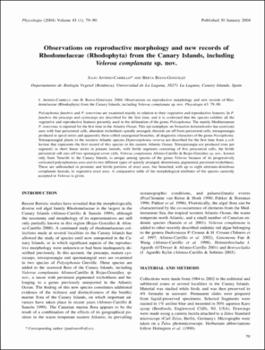Observations on reproductive morphology and new records of Rhodomelaceae (Rhodophyta) from the Canary Islands, including Veleroa complanata sp. nov.
Date
2004Abstract
Polysiphonia funebris and P. tenerrima are examined mainly in relation to their vegetative and reproductive features. In P.
funebris the procarps and cystocarps are described for the first time, and it is confirmed that the species exhibits all the
vegetative and reproductive features presently used in the del ineation of the genus Polysiphonia. The mainly Mediterranean
P. tenerrima is reported for the first time in the Atlantic Ocean. This epi-endophyte on Nemalion helminthoides has ecorticate
axes with four peri central cells, abundant trichoblasts spirally ananged, rhizoids cut off from pericentral cells, tetrasporangia
produced in spiral series and apparently three-celled carpogonial branches, all diagnostic characters of the genus Neosiphonia.
Tetrasporangial plants in the western Atlantic species Dipterosiphonia reversa are described for the first time from a collection that represents the first record of this species in the eastern Atlantic Ocean. Tetrasporangia are produced (one per
segment) in short linear series in pinnate laterals, with fertile segments consisting of five pericentral cells; the fertile
pericentral cell cuts off two sporangial cover cells. Veleroa complanata Afonso-Carrillo & Rojas-Gonzalez sp. nov., known
only from Tenerife in the Canary Islands, is unique among species of the genus Veleroa because of its progressively
corticated polysiphonous axes and its two different types of spirally arranged, determinate, pigmented, persistent trichoblasts.
These are unbranched in prostrate and fertile portions of erect axes, but branched, with up to eight alternate-distichous
complanate laterals, in vegetative erect axes. A comparative table of the morphological attributes of the species cunently
accepted in Veleroa is given.






